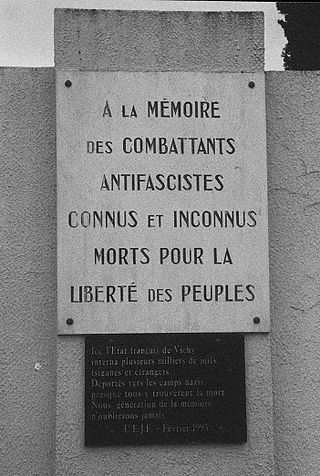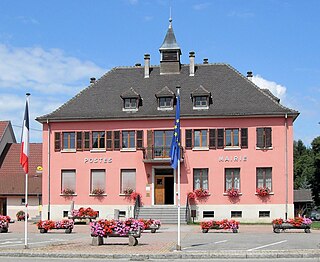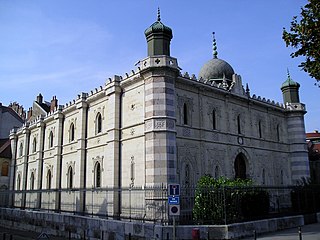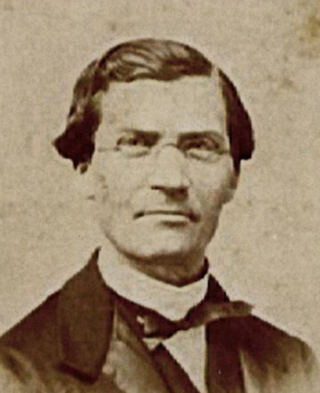History
While 32 Jewish tombs were found in a crypt underneath the Hôtel-Dieu de Lyon, [1] [2] the real cemetery was founded by a decision from the revolutionary government in 1795. [3]
In 1992, the cemetery was vandalized for the first time. [4] In 2004, 60 tombs of the cemetery were vandalized with Hitler's name, celtic cross and swastikas. [4] The perpetrator was believed to be a mentally ill man who supported far-right politics. [3] Jewish authorities and the French government expressed their dismay at the incident. Notably, local authorities were given "instructions to find the culprits of this odious act". [4] Additionally, Interior Minister Dominique de Villepin, declared that the "determination of public authorities to combat against all antisemitic acts will not be wavered". [4] The Cardinal of Lyon, Philippe Barbarin, equally expressed his "total solidarity and [his] full support to the Jewish community affected by this ignoble antisemitic act". [5]
While there are other Jewish cemeteries in the Lyon region, including Cimetière de Cusset in Villeurbanne, and the cemetery in Champagne-au-Mont-d'Or, this Jewish cemetery is the only Jewish cemetery in the city of Lyon and, with the Jewish cemetery of La Boisse in l'Ain, is administered by the Israelite Central Consistory of Lyon. [6]

The Union des étudiants juifs de France is a French organization that aims to assist French Jewish students.

The Union Libérale Israélite de France, commonly referred to as the rue Copernic synagogue, is a Reform Jewish congregation and synagogue, located in the XVIe arrondissement of Paris, France. Inaugurated on 1 December 1907, it is the oldest Reform synagogue in France.

William Bertrand Busnach was a French dramatist.

Durmenach is a commune in the Haut-Rhin department in Alsace in north-eastern France. It is one of the 120 villages that composes the Sundgau.

The beginnings of the history of the Jews in Besançon go back to the Middle Ages, a period during which the Jews settled in the city attracted by its activity as a commercial place. The community was founded at the end of the 14th century and, due to its status as a free imperial city, Besançon remained one of the only territories in present-day France to tolerate Jews after their expulsion from the kingdom of France in 1394. The community was nevertheless expelled in turn from Besançon in the middle of the 15th century. The Jews made a tentative return to the city in the 18th century, but it was only after the French Revolution, which emancipated them, that their situation in the Franche-Comté capital stabilized. Although the Jewish community never exceeded 2,000 people except on the eve of the Second World War, it experienced great economic success during the Industrial Revolution at the end of the 19th century, when the Lipmann family founded LIP, a brand of watchmaking which then became one of the economic engines of the region and remained associated with the name of the city.
Isaac Schneersohn was a French rabbi, industrialist, and the founder of the first Holocaust Archives and Memorial. He emigrated from Ukraine to France after the First World War.
Led by Philippe Pétain, the Vichy regime that replaced the French Third Republic in 1940 chose the path of collaboration with the Nazi occupiers. This policy included the Bousquet-Oberg accords of July 1942 that formalized the collaboration of the French police with the German police. This collaboration was manifested in particular by anti-Semitic measures taken by the Vichy government, and by its active participation in the genocide.

Guillotière Cemetery is the name of two adjacent but associated cemeteries in Lyon, France. The two cemeteries are distinguished according to when they were built: the new cemetery was built in 1854 and the old cemetery in 1822. They are situated in the La Guillotière neighborhood of the city, in the 7th and 8th arrondissements, just south of Parc Sergent Blandan. They were built to address the shortage of burial spaces in the city. The old cemetery is just north of the new cemetery, and the two are separated by Avenue Berthelot and the railroad tracks connecting Perrache and Part-Dieu railway stations. The new cemetery is the largest in Lyon at 18 hectares.
Doris Bensimon was an Austrian-born French sociologist and academic whose research focused on the study of contemporary Judaism. She taught at the University of Caen and Institut national des langues et civilisations orientales (INALCO).

The Commissariat-General for Jewish Affairs was a special administration established in March 1941 by the collaborationist Vichy government of France in order to introduce anti-Jewish legislation.

The Saint-Avold Synagogue is a Jewish congregation and synagogue, located at the corner of Rue des Americains and Rue de la Mertzelle near Place Paul-Collin in Saint-Avold, in the Moselle department in Grand Est in north-eastern France. The current synagogue building, completed in 1956, replaces a nearby synagogue destroyed during the German occupation of France in World War II.

The General Union of French Israelites was a body created by the antisemitic French politician Xavier Vallat under the Vichy regime after the Fall of France in World War II. UGIF was created by decree on 29 November 1941 following a German request, for the express purpose of enabling the discovery and classification of Jews in France and isolating them both morally and materially from the rest of the French population. It operated in two zones: the northern zone, chaired by André Baur, and the southern zone, under the chairmanship of Raymond-Raoul Lambert.
The Second French Statute on the Status of Jews, of 2 June 1941, was an anti-semitic law enacted under Vichy France and signed into law by the Head of the French State, Marshal Philippe Pétain. It replaced the first Law on the status of Jews of 3 October 1940. It included an increasingly stringent definition of who was a Jew in France. It specified a legal definition, of the term Jewish race, broadening its criteria for inclusion and extending the scope of the existing professional prohibitions. From that point on, Jews in France became second-class citizens, while they had since 21 September 1791 been full citizens.
Keren Or Synagogue is a Reform Jewish congregation and synagogue, located at 15 Rue Jules Vallès in Villeurbanne, in Lyon, in the Auvergne-Rhône-Alpes region of France.

The Law of 3 October 1940 on the status of Jews was a law enacted by Vichy France. It provided a legal definition of the expression Jewish race, which was used during the Nazi occupation for the implementation of Vichy's ideological policy of "National Revolution" comprising corporatist and antisemitic racial policies. It also listed the occupations forbidden to Jews meeting the definition. The law was signed by Marshall Philippe Pétain and the main members of his government.
The Law of 4 October 1940 regarding foreign nationals of the Jewish race was a law enacted by the Vichy regime, which authorized and organized the internment of foreign Jews and marked the beginning of the policy of collaboration of the Vichy regime with Nazi Germany's plans for the extermination of the Jews of Europe. This law was published in the Journal officiel de la République française on 18 October 1940.

Vitalis Haim Danon was a Jewish-Tunisian writer and professor. Danon is notable for his groundbreaking portrayal of day-to-day Jewish Tunisian life in his book, Ninette de la Rue du Péché.

Lehman Kahn, also known by the pseudonym L. K. Amitaï, was a Belgian Jewish educationist and writer.
Yonathan Arfi is a French CEO and activist. A member of the Conseil Représentatif des Institutions juives de France since 2002, he was elected as vice-president on 4 February 2014, and ran for president in 2022. On 26 June 2022, he succeeded Francis Kalifat as president of the CRIF.

The Jewish cemetery ofBayonne is a Jewish cemetery located in Bayonne, Nouvelle-Aquitaine. It is located in the Saint-Étienne quarter in the northern part of the city and north of the synagogue.















